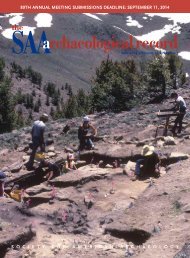SAA
Nov2016_web
Nov2016_web
Create successful ePaper yourself
Turn your PDF publications into a flip-book with our unique Google optimized e-Paper software.
VIDEO GAMES AND ARCHAEOLOGY<br />
Figure 1. Survey results indicating the division of gamers and non-gamers, as well as the gender balance, for student vs. staff respondents. Image by VALUE.<br />
the story (66 percent), and game characters (38 percent) are<br />
the three most important aspects of video games that attract<br />
archaeologists. 2 The respondents were then asked to list<br />
three games they have played that were “historical” and three<br />
games that were “archaeological.” The phrasing was purposefully<br />
vague to allow respondents to associate broadly on<br />
the topics of archaeology and history. Respondents listed<br />
more “historical” (171) than “archaeological” (91) games.<br />
More unique historical games were mentioned than archaeological<br />
games (38 and 25 different games, respectively).<br />
Additionally, historical games were repeated more frequently<br />
(see Table 1). These results show that “history” is more<br />
apparent in or more commonly associated with video games<br />
than “archaeology.” It also seems to indicate that history was<br />
more broadly associated with the past in games, while<br />
archaeology was related more specifically with (stereotypes<br />
of) the profession and methodology. As such, there is a clear<br />
Table 1. Historical and Archaeological Games as<br />
Identified by the Respondents.<br />
Most<br />
Most<br />
mentioned<br />
mentioned<br />
historical<br />
archaeological<br />
games<br />
games<br />
Age of Empires series (39) Tomb Raider series (29)<br />
Assassin’s Creed series (34) Civilization V (11)<br />
Total War series (22) Indiana Jones (6)<br />
potential for video games to incorporate more archaeological<br />
elements or gameplay in order to make our discipline’s<br />
unique understanding of the human past more immediately<br />
apparent to players.<br />
Enjoyment/Importance Paradox<br />
When it comes to the inclusion of archaeological aspects 3 in<br />
a game, the majority of respondents indicated that they<br />
highly enjoy them (see Figure 2): 51 percent stated that they<br />
found archaeology “a lot” or “extremely” enjoyable. Even so,<br />
they indicated that they felt neutral on average about the<br />
importance of these archaeological elements in video games.<br />
In other words, many archaeologists seek to play games that<br />
are linked to their studies or occupation, and they enjoy the<br />
incorporation of archaeology in games. This is the case even<br />
if the actual archaeological elements in these games are<br />
stereotypes, oversimplifications, or other forms of misrepresentation.<br />
This points to a paradoxical situation in which<br />
archaeologists enjoy games as entertainment but do not rate<br />
games to be an important and inherently valuable form of<br />
“infotainment” for archaeology. This paradox is further illustrated<br />
in the answers to an open question in our survey about<br />
the representativeness of archaeology in video games. 4<br />
When asked about this representativeness, we received<br />
mostly negative responses, centered on three issues. First, it<br />
was noted that games are more about treasure hunting than<br />
12 The <strong>SAA</strong> Archaeological Record • November 2016




